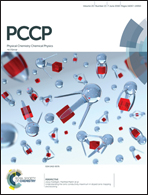Inelastic neutron scattering study of the lattice dynamics of the homologous compounds (PbSe)5(Bi2Se3)3m (m = 1, 2 and 3)
Abstract
We report on the inelastic response of the homologous compounds (PbSe)5(Bi2Se3)3m for m = 1, 2 and 3 followed in a broad temperature range (50–500 K) using high-resolution powder inelastic neutron scattering experiments. These results are complemented by low-temperature measurements of the specific heat (2–300 K). The evolution of the anisotropic crystal structure of these compounds with varying m, built from alternate Pb–Se and mBi–Se layers, only weakly influences the generalized phonon density of states. In all the three compounds, intense inelastic signals, likely mainly associated with the dynamics of the Pb atoms, are observed in the 4.5–6 meV low-energy range. The response of these low-energy modes to temperature variations indicates a conventional quasi-harmonic behavior over the whole temperature range investigated. The modes located above 8 meV show a minor temperature effect regardless of the value of m. The low-energy excess of vibrational modes manifests itself in the low-temperature specific heat as a pronounced peak in the Cp(T)/T3 data near 10 K. The lack of significant anharmonicity beyond that associated with the thermal expansion of the lattice suggests that the inherent disorder in the monoclinic unit cell and scattering at interlayer interfaces are the most important ingredients that limit the heat transport in this series of compounds.



 Please wait while we load your content...
Please wait while we load your content...